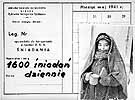
|
|
|

|

|

|

|
|
Click on an image to see a larger, more detailed picture.
|
|
|
|
|
| 1942: The "Final Solution" |

|
pg. 297 |

|
|
|
|
| |
 Soup kitchens run by local and international Jewish agencies proliferated in Nazi-occupied Poland. Once Polish Jews were concentrated in ghettos, their food supplies were controlled by the Germans. With food allocations limited to only a fraction of that required to maintain life, Polish Jews were dependent on supplemental nourishment provided by soup kitchens.
Soup kitchens run by local and international Jewish agencies proliferated in Nazi-occupied Poland. Once Polish Jews were concentrated in ghettos, their food supplies were controlled by the Germans. With food allocations limited to only a fraction of that required to maintain life, Polish Jews were dependent on supplemental nourishment provided by soup kitchens.
Photo: Rafal Imbro / United States Holocaust Memorial Museum Photo Archive
|
 Pictured here are identification cards that enabled the bearers to receive rations from the Kielce Ghetto soup kitchen, which was operated by the local Jewish Council. The first card, valid for breakfast only, says "1600 morning meals served daily." The second, a dinner pass, says "2100 dinners served daily."
Pictured here are identification cards that enabled the bearers to receive rations from the Kielce Ghetto soup kitchen, which was operated by the local Jewish Council. The first card, valid for breakfast only, says "1600 morning meals served daily." The second, a dinner pass, says "2100 dinners served daily."
Photo: Rafal Imbro / United States Holocaust Memorial Museum Photo Archive
|
 Exploitation or Extermination?
Exploitation or Extermination?
As the war expanded, Hitler urgently needed to stem the ever-growing labor shortage and increase production of war-related materiel. Of course, the Nazis could use Jews as slave labor, but did they want to put to work the same people they aimed to exterminate? These incompatible aims produced inconsistent policies that ultimately attempted to do both. At the Wannsee Conference, Reinhard Heydrich speculated that "a great part" of the Jews "evacuated to the East" and conscripted for labor would "undoubtedly be eliminated by natural causes." Accordingly, in 1942 the Nazis sought to extract more productive labor from the Jews before they died. Ghettos and labor camps then became for Jews mere transit stops on the road to death. Long hours of toil under inhuman conditions, coupled with brutal physical mistreatment, led to extremely high death rates. At Majdanek, 40 percent of those who died were victims of gassings and shootings, while 60 percent perished from the "natural causes" of work exhaustion, starvation, and disease. Inmate labor, such as moving piles of rocks back and forth, often served no productive purpose. SS guards took sadistic satisfaction in forcing Jews to perform backbreaking work, often prodding their prisoners with a hail of blows or even electric shocks.
Photo: Benjamin Reed/United States Holocaust Memorial Museum Photo Archive
|
|

|

|

|

|
 1942: The American Council for Judaism, an anti-Zionist organization, is co-founded in New York by New York Times publisher Arthur Hays Sulzberger.
1942: The American Council for Judaism, an anti-Zionist organization, is co-founded in New York by New York Times publisher Arthur Hays Sulzberger.
|
 1942: German Protestant theologian Karl Friedrich Stellbrink is arrested after disseminating letters of anti-Nazi Bishop Clemens August Graf von Galen; See November 10, 1943.
1942: German Protestant theologian Karl Friedrich Stellbrink is arrested after disseminating letters of anti-Nazi Bishop Clemens August Graf von Galen; See November 10, 1943.
|
 1942: Hitler names Albert Speer minister for armaments and munitions.
1942: Hitler names Albert Speer minister for armaments and munitions.
|
 1942: Yitzhak Shamir succeeds Abraham Stern as head of the Zionist Stern Gang in Palestine after Stern is killed by British security forces.
1942: Yitzhak Shamir succeeds Abraham Stern as head of the Zionist Stern Gang in Palestine after Stern is killed by British security forces.
|
 1942: The Jewish Combat Organization, a resistance group, is formed in Warsaw, Poland.
1942: The Jewish Combat Organization, a resistance group, is formed in Warsaw, Poland.
|
 1942: Janusz Korczak, director of a Jewish orphanage in Warsaw, refuses an offer of freedom from his Polish friends and accompanies his young charges to Treblinka.
1942: Janusz Korczak, director of a Jewish orphanage in Warsaw, refuses an offer of freedom from his Polish friends and accompanies his young charges to Treblinka.
|
 1942: The Antifascist Bloc, an amalgamation of Jewish Communists and Zionist Socialists, begins publication of Der Ruf (The Call), an underground, anti-Nazi newspaper.
1942: The Antifascist Bloc, an amalgamation of Jewish Communists and Zionist Socialists, begins publication of Der Ruf (The Call), an underground, anti-Nazi newspaper.
|
|
|
|
|
| 1942: The "Final Solution" |

|
pg. 297 |

|
|
The Holocaust Chronicle
© 2009 Publications International, Ltd.
|
|
